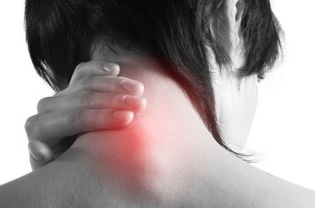
Osteochondrosis is an injury of the intervertebral discs of a degenerative-dystrophic nature and the cervical region is the most vulnerable part of the spine, which has an anatomically different structure of very close vertebrae and a corsetof weak muscle. Therefore, even with small additional loads on the neck, vertebral displacement can occur, leading to compression of blood vessels and nerves.
And since the vertebral arteries that are involved in the blood supply to the brain pass through holes in the transverse processes of the vertebrae in this section, numbness of the vertebrae in this section or squeezing of the holes by adult osteophytes is fraught with very serious consequences. severe.
What is this?
Osteochondrosis of the cervical spine is a progressive polyetiological disease, which is manifested by degeneration of the intervertebral discs and degeneration of the ligamentous apparatus of the spine.
Reasons for
The main causes and preconditions for the occurrence of cervical vertebral osteochondrosis are:
- Spine curvature, scoliosis.
- Stress, nervous tension negatively affect the general condition of the body, can cause osteochondrosis of the cervix.
- Past infectious diseases often become the leading cause.
- Incorrect and uncomfortable body position during sleep (for example, uncomfortable pillow).
- Congenital problems or the presence of hereditary diseases of the cervical spine.
- Poor attitude towards youth and adolescence.
- Overweight, overweight to varying degrees. The extra pounds increase the load on the vertebrae and discs, which leads to degenerative processes.
- Back injuries that may have occurred during childhood or adolescence.
- Disruption of metabolic processes.
- Work related to physical work, which can provoke spinal diseases in different parts of it.
- Inactive living, sedentary work, improper exercise.
For the successful treatment of cervical osteochondrosis, it is first necessary to determine the cause of the occurrence, the preconditions that provoked its development and eliminate them. Until recently, the disease occurred only in people over the age of 45 years. Now young people are exposed to it, the age range is 18-25 years.
Characteristics of the cervical spine
Let us consider how the cervical spine differs from the rest of the spine, and that during the development of osteochondrosis is a prerequisite for the development of these syndromes.
- Important ganglia (nodes) of the autonomic nervous system are located in the cervical region.
- In the transverse processes of the vertebrae there are holes that form a channel through which the vertebral artery passes, which supplies oxygen and nutrients to the brain, cerebellum, auditory organs and also the vertebral nerve. These are prerequisites for frequent capture of the artery and nerve.
- The cervical spine is the most mobile. It is characterized by all kinds of movements completely. These are prerequisites for frequent violations and delusions.
- The intervertebral foramen of the lower three vertebrae is not round but triangular. These are prerequisites for capturing nerve roots from the bone growths that form in osteochondrosis.
- The intervertebral discs are not located between the vertebral bodies along their entire length. At the front, instead, there are protruding edges of the beads, which are connected by knots. These are prerequisites for the occurrence of joint subluxation.
Stages of development
The degree of osteochondrosis is determined by the clinical appearance and complaints of the patient. The concept of degree should not be confused with the stages of osteochondrosis. The stages are discussed below.
- First degree. Clinical manifestations are minimal, the patient may complain of low-intensity cervical pain, which may worsen when turning the head. Physical examination may show slight muscle tension in the neck.
- Second degree. The patient is worried about the pain in the back of the cervix, its intensity is much greater, there may be radiation in the shoulder, in the arm. This occurs due to a decrease in the height of the intervertebral disc and pinching of the nerve roots. Painful sensations increase when tilting and turning the head. The patient may notice decreased performance, weakness, headache.
- Third degree. The symptoms of cervical osteochondrosis intensify, the pain becomes constant with radiation to the arm or shoulder. Numbness or weakness appears in the arm muscles as herniated intervertebral discs form. Worried about weakness, dizziness. Examination reveals limited mobility in the cervical spine, pain when touching the cervical spine.
- Fourth degree. There is a complete destruction of the intervertebral disc and its replacement with connective tissue. Dizziness increases, tinnitus appears, impaired coordination, as the process involves the vertebral artery feeding the cerebellum and the occipital lobe of the brain.
Symptoms
The severity of the symptoms of cervical osteochondrosis depends on the degree of destruction of the vertebral structures. Symptoms are exacerbated by the growth of bone tissue with the formation of osteophytes, radicular syndrome (radicular pain when a nerve is compressed), intervertebral hernia (disc protrusion in the spinal canal).
The first signs of the disease are recurrent headaches in the neck, soreness in the neck, pressure and clicks on the vertebrae when turning the head, and a slight tingling sensation in the shoulders. Over time, the symptoms increase and the intensity of the pain increases.
Pain syndrome is the main manifestation of osteochondrosis. Neck pain is either dull, persistent or sharp with the lumbago below the neck when you turn your head. The entire cervical region or the projection area of the modified vertebra, as well as the clavicle, shoulders, shoulders, and heart area, can be damaged. Radiation pain in the lower jaw, teeth, arm, ear, eye area is not excluded. The neck and shoulder muscles are tense, painful to the touch. Difficulty in raising the arm on the side of the lesion - immediately there is a lumbago on the shoulder or neck. Restriction of head movements due to pain often occurs in the morning after sleep in an uncomfortable position.
The disease leads to compression of the roots of peripheral nerves (radicular syndrome) and causes pain along the course of these nerves. Possibly numbness of the hands or fingers, impaired sensitivity of certain areas of the skin that are irritated by the tight nerve.
Some characteristic symptoms suggest which vertebrae are affected:
- C1 - impaired sensitivity in the occupational region;
- C2 - pain in the occipital and parietal regions;
- C3 - decreased sensitivity and pain in half of the neck where the spinal nerve was injured, impaired sensitivity of the tongue, impaired speech due to loss of control over the tongue;
- C4 - impaired sensitivity and pain in the shoulder-shoulder region, decreased head and neck muscle tone, possible respiratory disorders, liver and heart pain;
- C5 - pain and sensory discomfort on the outer surface of the shoulder;
- C6 - pain extending from the neck to the shoulder blade, forearm, outer surface of the shoulder, radial surface of the forearm to the thumb;
- C7 - pain extending from neck to shoulder, back of shoulder, forearm to fingers II - IV of hand, impaired tenderness in this area.
- C8 - pain and sensory disturbances spread from neck to shoulder, forearm to little finger.
Osteochondrosis of the cervix is always accompanied by a headache. Severe, persistent pain worsens by turning the neck or sudden movements. Some patients complain of weight on the head. Compression of the vertebral artery leads to periods of dizziness, vomiting. There is noise, ringing in the ears, trembling of blackheads in front of the eyes. Deterioration of cerebral circulation provokes a progressive decrease in hearing and visual acuity, numbness of the tongue and a change in taste.
Clicks or presses during neck movements almost always accompany cervical osteochondrosis, observed in every patient. Chewing occurs during a sharp turn of the head or by throwing it back.
Syndromes due to cervical osteochondrosis
The symptoms of cervical osteochondrosis are grouped into specific groups called syndromes. Their presence and severity may indicate a pathology in the cervical spine with a specified localization.
A group of common syndromes:
- Vegetative-dystonic syndrome. Subluxation of the first cervical vertebra with displacement may lead to the development of vegetative-vascular dystonia. VSD is not a definite diagnosis, as there are no pronounced symptoms. There may be neurological signs, symptoms of impaired cerebral blood flow, increased intracranial pressure, muscle spasms. As a result, patient complaints are reduced to dizziness, decreased visual acuity, loss of consciousness, headache, nausea.
- Irritating - reflective. Sharp burning and pain in the back of the head and neck, sometimes with a turn in the chest and shoulder, arising at the time of a change in the position of the head and neck, with sneezing and a sharp turn of the head.
- Vertebral artery syndrome. It develops directly both by compression of the artery itself and by irritation of the sympathetic nerve plexus, which is located around it. The pain in this pathology is burning or throbbing in the occipital region with spread to the temples, superciliary arches, crown. It happens on both sides. Patients usually associate the deterioration with the condition after sleeping in a non-physiological position, traveling in transport, walking. With severe symptoms, hearing loss, dizziness, tinnitus, nausea, vomiting, loss of consciousness, high blood pressure are possible.
Diagnosis
As with any medical diagnosis, the diagnosis of osteochondrosis is made on the basis of patient complaints, medical history, clinical examination, and ancillary research methods. Radiography of the cervical spine is performed in frontal and lateral projections, if necessary in special positions (with one mouth open). At the same time, specialists are interested in the height of the intervertebral discs, the presence of osteophytes.
Of the modern research methods, NMR and CT studies are used, which allow more accurate verification of the diagnosis. In addition to the listed additional research methods, consultation with related specialists (cardiologist, ophthalmologist, neurosurgeon) may be needed and examination by a neurologist is simply vital. A neurologist is engaged in the treatment of osteochondrosis, therefore, after examining the patient, he, in his judgment, will prescribe the minimum necessary examination.
How to treat osteochondrosis of the cervical spine?
Complex treatment of cervical osteochondrosis may include the following traditional and non-traditional methods: drug treatment, massage, acupressure, manual therapy, physiotherapy, acupuncture, homeopathy, folk remedies, etc.
The main treatment regimen for osteochondrosis is the same for all localizations of this disease:
- First you need to relieve the pain.
- Then the swelling is relieved.
- At this stage it is necessary to normalize blood circulation.
- Strengthening the muscular corset.
- Improving nutrition and tissue regeneration.
The list of medicines and drugs for the treatment of cervical osteochondrosis at home is very extensive:
- Anti-inflammatory (steroid). These are hormonal medications that relieve inflammation and, thus, eliminate pain;
- Analgesics (non-steroidal pain relievers). They are usually described as tablets or capsules. It should be remembered that most of these drugs cause irritation of the mucous membranes of the digestive tract;
- Muscle relaxants are medicines that relax muscle tone. They are used in surgery and orthopedics as aids in relieving pain. These drugs are administered parenterally and are therefore always under medical supervision. There is an extensive list of contraindications;
- Chondroprotectors are medicines that contain substances that replace cartilage tissue components. To achieve a lasting positive effect, such drugs must be taken for a very long time;
- Ointments and gels for external use. This is the most accessible group of medicines for home use. They are divided into relieving inflammation, heat and pain relievers. Such funds are often advertised. With cervical osteochondrosis, not all oils are effective, in addition, due to their availability, they are sometimes used unreasonably and regardless of the features of pathogenesis.
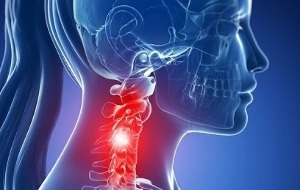
Only a good team of specialists can choose the most appropriate therapy, which includes a neurologist, physiotherapist, massage therapist, surgeon and vertebral neurologist.
Physiotherapy
Exercise therapy for cervical osteochondrosis should be performed outside of acute exacerbation. The greatest efficiency of this technique is during the recovery period. There should be no discomfort and pain during the execution of the complex!
- Exercise # 1. Lying on your stomach, place your hands on the floor, raise your head and torso, your back should be straight. Stay in this position for 1-2 minutes. Sit slowly on the floor. Repeat 2-3 times.
- Exercise # 2. Lying on your stomach, spread your arms along your body, turn your head to the left, try to touch the floor with your ear, then turn your head to the right. Repeat 6-7 times in each direction.
- Exercise # 3. In a sitting position while sucking, bend forward and try to touch your chest with your head, then exhale, bend and tilt your head back. Repeat 10-15 times.
- Exercise # 4. While sitting, place your palms on your forehead, apply pressure with your palms on your forehead and forehead on your palms. Continue this exercise for 30 seconds. Repeat 2-3 times.
- Exercise # 5. Slowly rotate your head first in one direction, then in the other. 10 turns in each direction. Look dizzy. When it appears, the exercise stops.
Massage Therapy
Massage can be done at home, but very carefully so as not to aggravate and harm the patient. The patient should take a prone position, place the forehead on the hands and extend the chin towards the chest. The neck muscles should be completely relaxed.
- Stroking. It is necessary to start the massage with these movements: stroking the collar area in the direction from the lymph to the supraclavicular and axillary joints. Then apply flat strokes and comb.
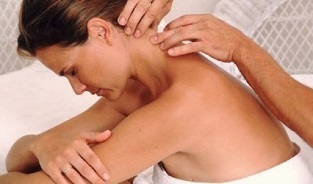
Massage is needed to strengthen muscle tone and relieve pain. Depending on the stage in which osteochondrosis is, a massage technique is chosen. However, while massaging the neck, specialists use all the techniques of classical massage: rubbing, stroking, stirring, etc. In cases where the patient has pain in only one side, the massage begins in the healthy part of the neck, gradually moving to that part of the collar area where painful sensations arise.
Manual therapy
Manual therapy helps to cope with acute and chronic pain, it also increases range of motion and improves posture well. Main methods of manual therapy for osteochondrosis of the cervical spine:
- Relaxing and segmental massage. Used to warm muscles and relieve tension.
The chiropractor should be fluent in these techniques. Otherwise, any error may result in damage.
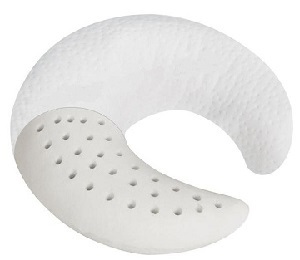
Orthopedic pillows
Orthopedic sleeping pillows are an effective prevention tool. In many cases, osteochondrosis is aggravated by the extra compression of the cervical artery and nerve roots while sleeping on an uncomfortable pillow. The orthopedic product ensures a uniform horizontal position of a person during sleep and, thus, guarantees a physiologically proper blood supply to the brain.
When choosing a pillow, you need to consider the individual anatomical features of a person and relate them to the volume and characteristics of the filler. A properly selected pillow brings tangible benefits to a patient with cervical osteochondrosis.
Physiotherapy
Physiotherapy procedures for osteochondrosis of the cervical spine:
- Laser therapy. Improves blood circulation in the affected area, relieves tissue swelling, pain.
Physiotherapy procedures have a beneficial effect on discs and vertebrae in cervical osteochondrosis. In combination with taking medication, the combined treatment helps in relieving the symptoms of the disease. Procedures are performed in a hospital or in specialized rooms in polyclinics. Before starting the course, you should consult a doctor, determine the duration of physiotherapy, types. Strictly forbidden to cross during a deterioration.
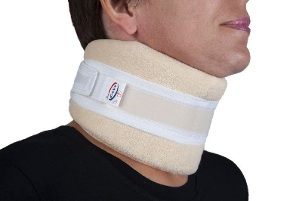
Trench collar
Shants collar is a soft and comfortable device, fastened with Velcro on the back and used for osteochondrosis of the cervix. But not for treatment, but for temporary relaxation and relief of fatigue. It can not be worn without removing it, otherwise the neck muscles will stop working and will soon atrophy. If the Shants collar is chosen correctly, the patient feels comfortable and protected.
The collar is chosen exactly according to the size in the pharmacy or orthopedic shop. Better in a store, because the people who work there, as a rule, know quite well their business and product features, which means that they can help in any specific case.
Folk remedies
If the pain from spinal osteochondrosis becomes unbearable and regular, then you will agree on everything to stop it, and here the traditional complex treatment will be successfully complemented by the alternative method.
- insist on celery root (5 grams per 1 liter of boiling water) for 4 hours, drink a tablespoon before each meal;
- honey compress, for which we take 2 tablespoons. honey and 1 tablet zombie. We heat the ingredients in a water bath, spread on a cloth and place in the cervical region, i. e. at the neck, at night;
- in case of an acute pain, locally grown grapes help me. I just wash his sheet, pour boiling water over him, cool him a little, put him on his neck and wrap him in a thin scarf for the night - in the morning you can already live and work;
- we insist on chamomile flowers in vegetable oil for two days, heat to boiling (for 500 ml of oil you need 30 grams of a plant), rub into painful areas;
- honey-potato compress also helps, for this, the root crop should be ground and mixed with honey in the same amount, applied to neck pain at night, used regularly, at least once a week. x / li>
Prevention
As usual, proper prophylaxis will help avoid cervical osteochondrosis, but, of course, all physical exercise should be used regularly, otherwise there will be little benefit from "periodic" exercise.
It remains to remember simple rules:
- Eat lots of foods with calcium and magnesium. These are fish, peas, legumes, nuts, cheese, herbs, but it is better to refrain from sugar, flour, smoked, spicy.
- Regularly engage in sports, especially swimming, water gymnastics and gymnastics for stretching and flexibility of the vertebrae is also suitable for the prevention of osteochondrosis, which can be practiced at home.
- When you are sitting, do a special set of exercises at least twice a day.
- Choose a good orthopedic mattress and pillow that is ideal for the neck, supporting the head in the right anatomical position during sleep (yes, your favorite down pillows will not go away with spinal problems! )
If you already have such a diagnosis, then the patient should save the spine, namely:
- Be very careful with lifting and carrying weights, it is better to go to the store twice than to pull heavy bags in both hands, incredibly straining the neck and shoulder girdle;
- Do not get too cold, avoid drafts and cold air leaking from the air conditioner (some people like to cool down on a hot day by standing with their backs to the fan);
- When tilting your luggage forward - remember about osteochondrosis;
- Avoid local muscle overheating, which can occur in overheated baths;
- Remember to periodically disconnect from the monitor, change body position, do not sit for hours, even days;
- Rest your neck by buying a Shants collar;
- If possible, if the condition of the cardiovascular system allows, take a steam bath.
In conclusion, I would like to say that a child who is at risk for osteochondrosis (father and mother already have it) and an adult who acquired the disease during life are simply forced to take preventive measures in order tonot to become disabled and not to end up on the operating table, Above all, this operation is quite complicated and requires long-term rehabilitation. In addition, it is not always possible because there are inoperable cases, so it is better to protect your health from a young age, as long as the discs are intact and unnecessary growths do not squeeze the blood vessels.





































